2021 NISSAN NV200 odometer
[x] Cancel search: odometerPage 119 of 300
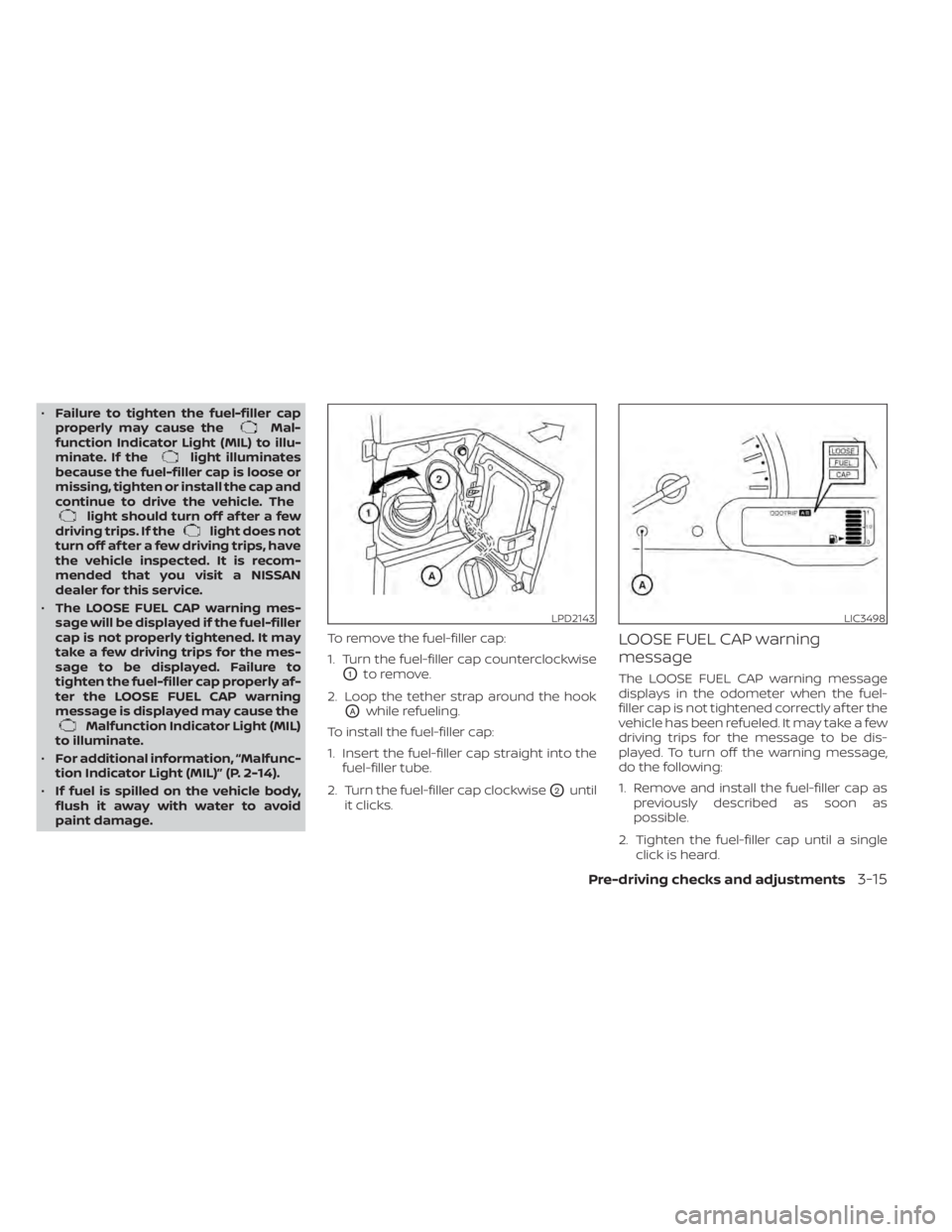
•Failure to tighten the fuel-filler cap
properly may cause theMal-
function Indicator Light (MIL) to illu-
minate. If the
light illuminates
because the fuel-filler cap is loose or
missing, tighten or install the cap and
continue to drive the vehicle. The
light should turn off af ter a few
driving trips. If thelight does not
turn off af ter a few driving trips, have
the vehicle inspected. It is recom-
mended that you visit a NISSAN
dealer for this service.
• The LOOSE FUEL CAP warning mes-
sage will be displayed if the fuel-filler
cap is not properly tightened. It may
take a few driving trips for the mes-
sage to be displayed. Failure to
tighten the fuel-filler cap properly af-
ter the LOOSE FUEL CAP warning
message is displayed may cause the
Malfunction Indicator Light (MIL)
to illuminate.
• For additional information, “Malfunc-
tion Indicator Light (MIL)” (P. 2-14).
• If fuel is spilled on the vehicle body,
flush it away with water to avoid
paint damage. To remove the fuel-filler cap:
1. Turn the fuel-filler cap counterclockwise
O1to remove.
2. Loop the tether strap around the hook
OAwhile refueling.
To install the fuel-filler cap:
1. Insert the fuel-filler cap straight into the fuel-filler tube.
2. Turn the fuel-filler cap clockwise
O2until
it clicks.
LOOSE FUEL CAP warning
message
The LOOSE FUEL CAP warning message
displays in the odometer when the fuel-
filler cap is not tightened correctly af ter the
vehicle has been refueled. It may take a few
driving trips for the message to be dis-
played. To turn off the warning message,
do the following:
1. Remove and install the fuel-filler cap as previously described as soon as
possible.
2. Tighten the fuel-filler cap until a single click is heard.
LPD2143LIC3498
Page 146 of 300
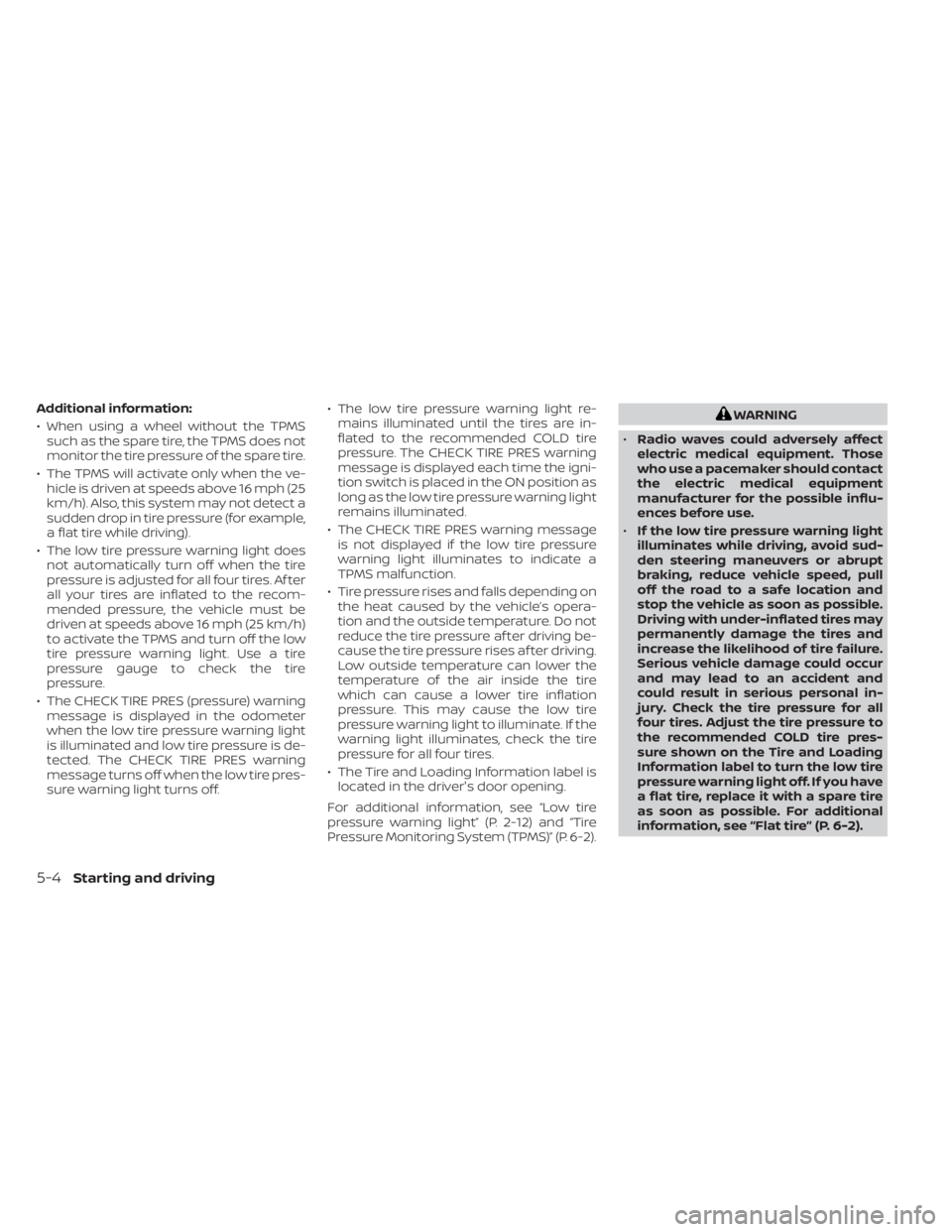
Additional information:
• When using a wheel without the TPMSsuch as the spare tire, the TPMS does not
monitor the tire pressure of the spare tire.
• The TPMS will activate only when the ve- hicle is driven at speeds above 16 mph (25
km/h). Also, this system may not detect a
sudden drop in tire pressure (for example,
a flat tire while driving).
• The low tire pressure warning light does not automatically turn off when the tire
pressure is adjusted for all four tires. Af ter
all your tires are inflated to the recom-
mended pressure, the vehicle must be
driven at speeds above 16 mph (25 km/h)
to activate the TPMS and turn off the low
tire pressure warning light. Use a tire
pressure gauge to check the tire
pressure.
• The CHECK TIRE PRES (pressure) warning message is displayed in the odometer
when the low tire pressure warning light
is illuminated and low tire pressure is de-
tected. The CHECK TIRE PRES warning
message turns off when the low tire pres-
sure warning light turns off. • The low tire pressure warning light re-
mains illuminated until the tires are in-
flated to the recommended COLD tire
pressure. The CHECK TIRE PRES warning
message is displayed each time the igni-
tion switch is placed in the ON position as
long as the low tire pressure warning light
remains illuminated.
• The CHECK TIRE PRES warning message is not displayed if the low tire pressure
warning light illuminates to indicate a
TPMS malfunction.
• Tire pressure rises and falls depending on the heat caused by the vehicle’s opera-
tion and the outside temperature. Do not
reduce the tire pressure af ter driving be-
cause the tire pressure rises af ter driving.
Low outside temperature can lower the
temperature of the air inside the tire
which can cause a lower tire inflation
pressure. This may cause the low tire
pressure warning light to illuminate. If the
warning light illuminates, check the tire
pressure for all four tires.
• The Tire and Loading Information label is located in the driver's door opening.
For additional information, see “Low tire
pressure warning light” (P. 2-12) and “Tire
Pressure Monitoring System (TPMS)” (P. 6-2).
Page 293 of 300
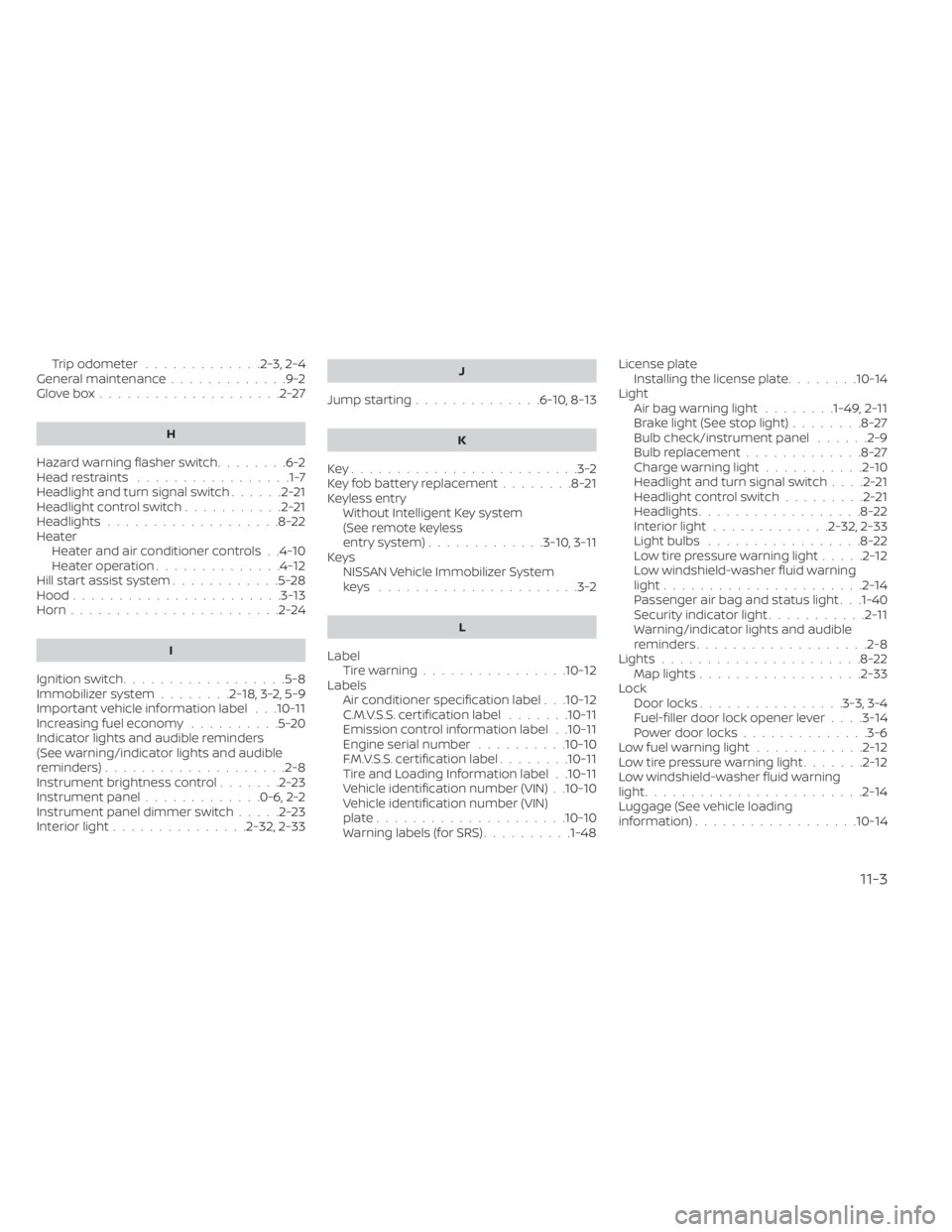
Trip odometer.............2-3, 2-4General maintenance.............9-2Glove box....................2-27
H
Hazard warning flasher switch........6-2Head restraints.................1-7Headlight and turn signal switch......2-21Headlight control switch...........2-21Headlights...................8-22HeaterHeater and air conditioner controls. .4-10Heater operation..............4-12Hill start assist system............5-28Hood.......................3-13Horn.......................2-24
I
Ignition switch................. .5-8Immobilizer system........2-18,3-2,5-9Important vehicle information label. . .10-11Increasing fuel economy..........5-20Indicator lights and audible reminders
(See warning/indicator lights and audible
reminders)
................... .2-8Instrument brightness control.......2-23Instrument panel.............0-6, 2-2Instrument panel dimmer switch.....2-23Interior light...............2-32, 2-33
J
Jump starting..............6-10,8-13
K
Key.........................3-2Key fob battery replacement........8-21Keyless entry
Without Intelligent Key system
(See remote keyless
entry system)
.............3-10,3-11KeysNISSAN Vehicle Immobilizer System
keys
......................3-2
L
LabelTire warning................10-12LabelsAir conditioner specification label. . .10-12C.M.V.S.S. certification label.......10-11Emission control information label. .10-11Engine serial number..........10-10F.M.V.S.S. certification label........10-11Tire and Loading Information label. .10-11Vehicle identification number (VIN). .10-10Vehicle identification number (VIN)
plate.................... .10-10Warning labels (for SRS)..........1-48
License plate
Installing the license plate........10-14LightAir bag warning light........1-49, 2-11Brake light (See stop light)........8-27Bulb check/instrument panel......2-9Bulb replacement.............8-27Charge warning light...........2-10Headlight and turn signal switch. . . .2-21Headlight control switch.........2-21Headlights..................8-22Interior light.............2-32, 2-33Light bulbs.................8-22Low tire pressure warning light.....2-12Low windshield-washer fluid warning
light......................2-14Passenger air bag and status light. . .1-40Security indicator light...........2-11Warning/indicator lights and audible
reminders.................. .2-8Lights......................8-22Map lights..................2-33Lock
Door locks................3-3, 3-4Fuel-filler door lock opener lever. . . .3-14Power door locks..............3-6Low fuel warning light............2-12Low tire pressure warning light.......2-12Low windshield-washer fluid warning
light........................2-14Luggage (See vehicle loading
information)................. .10-14
11-3
Page 294 of 300
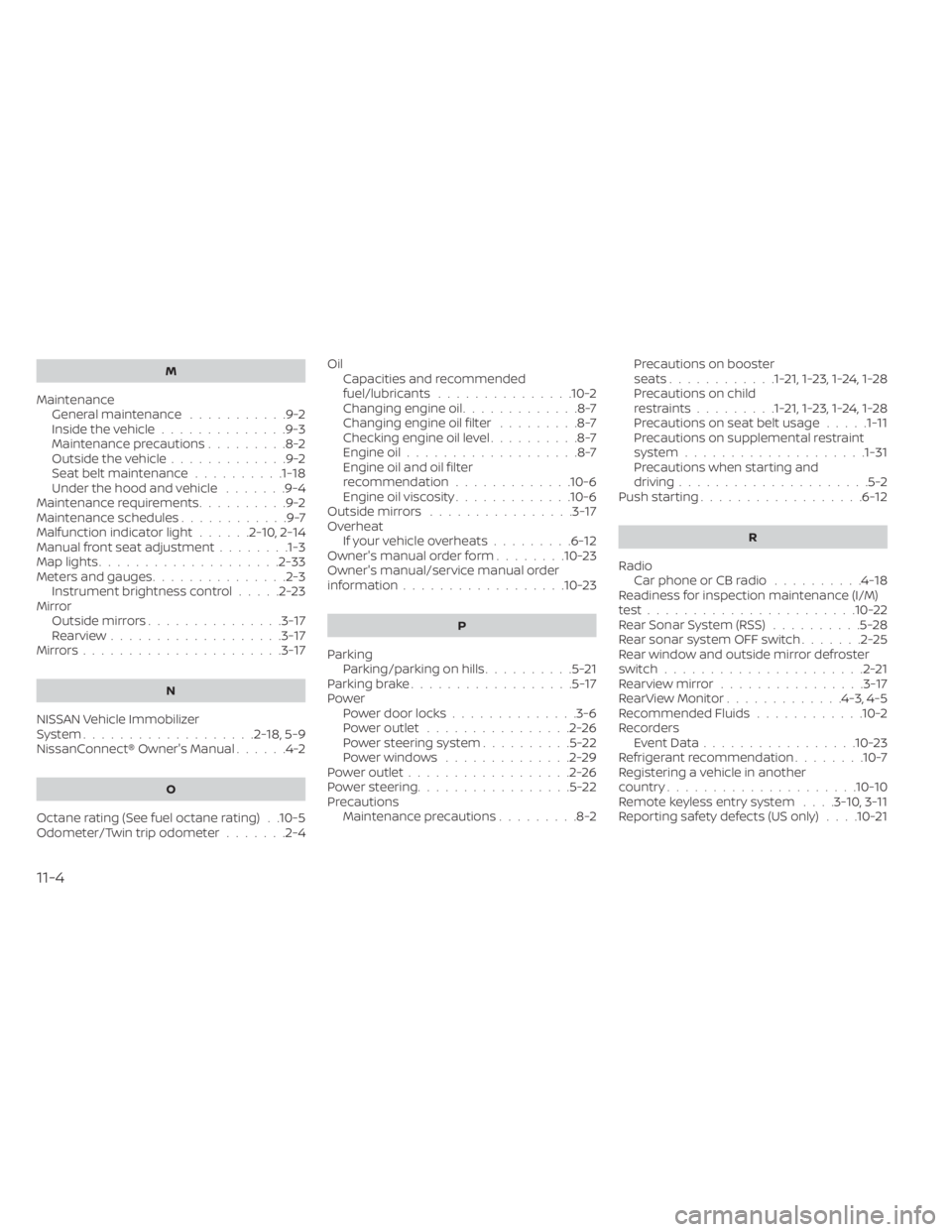
M
MaintenanceGeneral maintenance...........9-2Inside the vehicle..............9-3Maintenance precautions.........8-2Outside the vehicle.............9-2Seat belt maintenance..........1-18Under the hood and vehicle.......9-4Maintenance requirements..........9-2Maintenance schedules............9-7Malfunction indicator light......2-10,2-14Manual front seat adjustment........1-3Map lights................... .2-33Meters and gauges...............2-3Instrument brightness control.....2-23Mirror
Outside mirrors...............3-17Rearview...................3-17Mirrors......................3-17
N
NISSAN Vehicle Immobilizer
System...................2-18,5-9NissanConnect® Owner's Manual......4-2
O
Octane rating (See fuel octane rating). .10-5Odometer/Twin trip odometer.......2-4
OilCapacities and recommended
fuel/lubricants
...............10-2Changing engine oil.............8-7Changing engine oil filter.........8-7Checking engine oil level..........8-7Engine oil...................8-7Engine oil and oil filter
recommendation.............10-6Engine oil viscosity.............10-6Outside mirrors................3-17OverheatIf your vehicle overheats.........6-12Owner's manual order form........10-23Owner's manual/service manual order
information................. .10-23
P
Parking
Parking/parking on hills..........5-21Parking brake..................5-17PowerPower door locks..............3-6Power outlet................2-26Power steering system..........5-22Power windows..............2-29Power outlet..................2-26Power steering.................5-22PrecautionsMaintenance precautions.........8-2
Precautions on booster
seats............1-21,1-23,1-24,1-28Precautions on child
restraints.........1-21,1-23,1-24,1-28Precautions on seat belt usage.....1-11Precautions on supplemental restraint
system................... .1-31Precautions when starting and
driving.....................5-2Push starting..................6-12
R
Radio
Car phone or CB radio..........4-18Readiness for inspection maintenance (I/M)
test...................... .10-22Rear Sonar System (RSS)..........5-28Rear sonar system OFF switch.......2-25Rear window and outside mirror defroster
switch......................2-21Rearview mirror................3-17RearView Monitor.............4-3, 4-5Recommended Fluids............10-2Recorders
Event Data................ .10-23Refrigerant recommendation........10-7Registering a vehicle in another
country.................... .10-10Remote keyless entry system. . . .3-10, 3-11Reporting safety defects (US only). . . .10-21
11-4
Page 296 of 300
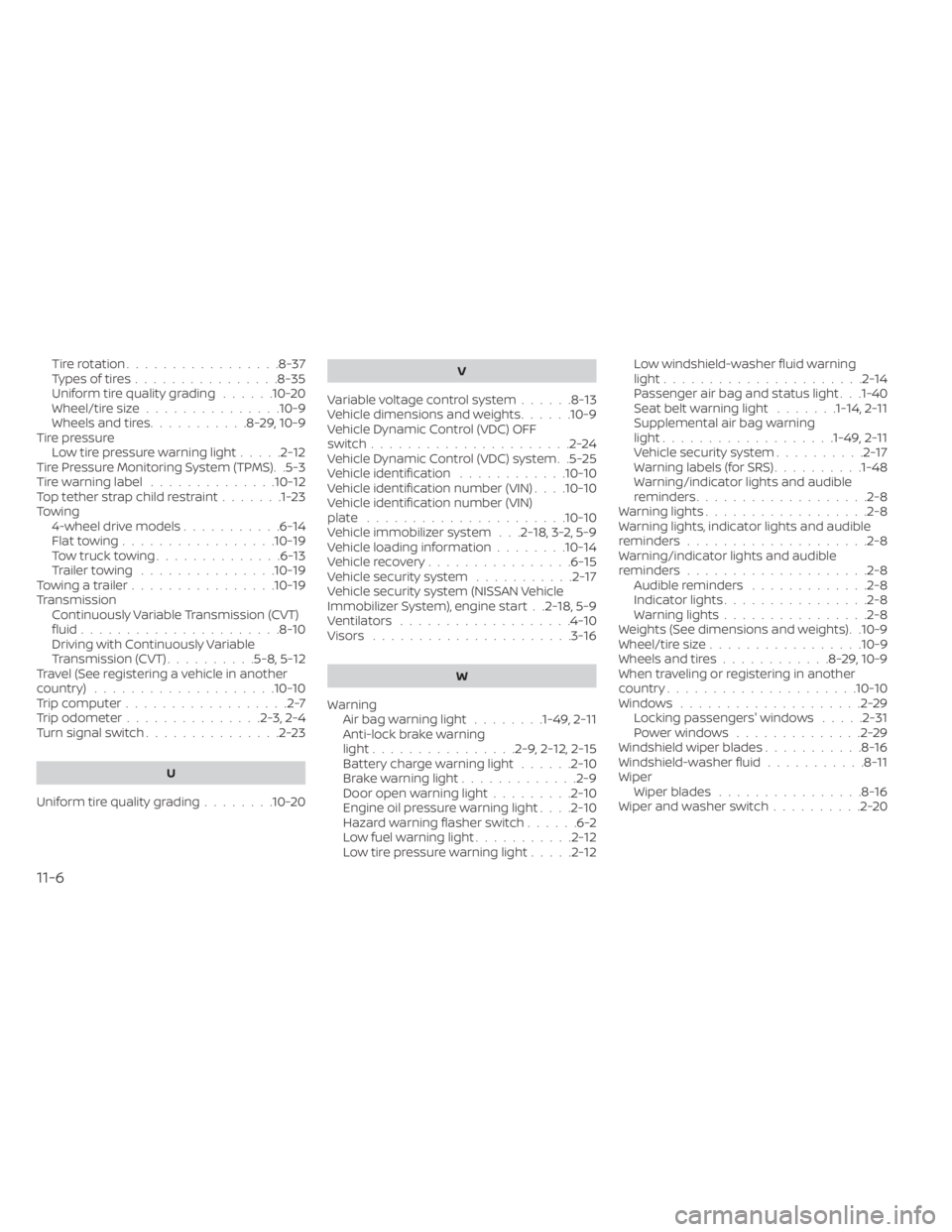
Tire rotation.................8-37Types of tires................8-35Uniform tire quality grading......10-20Wheel/tire size...............10-9Wheels and tires...........8-29,10-9Tire pressure
Low tire pressure warning light.....2-12Tire Pressure Monitoring System (TPMS). .5-3Tire warning label..............10-12Top tether strap child restraint.......1-23Towing4-wheel drive models...........6-14Flat towing................ .10-19Tow truck towing..............6-13Trailer towing...............10-19Towing a trailer................10-19Transmission
Continuously Variable Transmission (CVT)
fluid
......................8-10Driving with Continuously Variable
Transmission (CVT)..........5-8, 5-12Travel (See registering a vehicle in another
country)................... .10-10Trip computer..................2-7Trip odometer...............2-3, 2-4Turn signal switch...............2-23
U
Uniform tire quality grading........10-20
V
Variable voltage control system......8-13Vehicle dimensions and weights......10-9Vehicle Dynamic Control (VDC) OFF
switch......................2-24Vehicle Dynamic Control (VDC) system. .5-25Vehicle identification............10-10Vehicle identification number (VIN). . . .10-10Vehicle identification number (VIN)
plate..................... .10-10Vehicle immobilizer system. . .2-18, 3-2, 5-9Vehicle loading information........10-14Vehicle recovery................6-15Vehicle security system...........2-17Vehicle security system (NISSAN Vehicle
Immobilizer System), engine start. .2-18, 5-9Ventilators...................4-10Visors......................3-16
W
Warning
Air bag warning light........1-49, 2-11Anti-lock brake warning
light................2-9, 2-12, 2-15Battery charge warning light......2-10Brake warning light.............2-9Door open warning light.........2-10Engine oil pressure warning light. . . .2-10Hazard warning flasher switch......6-2Low fuel warning light...........2-12Low tire pressure warning light.....2-12
Low windshield-washer fluid warning
light......................2-14Passenger air bag and status light. . .1-40Seat belt warning light.......1-14,2-11Supplemental air bag warning
light.................. .1-49, 2-11Vehicle security system..........2-17Warning labels (for SRS)..........1-48Warning/indicator lights and audible
reminders...................2-8Warning lights..................2-8Warning lights, indicator lights and audible
reminders................... .2-8Warning/indicator lights and audible
reminders....................2-8Audible reminders.............2-8Indicator lights................2-8Warning lights................2-8Weights (See dimensions and weights). .10-9Wheel/tire size.................10-9Wheels and tires............8-29,10-9When traveling or registering in another
country.................... .10-10Windows....................2-29Locking passengers' windows.....2-31Power windows..............2-29Windshield wiper blades...........8-16Windshield-washer fluid...........8-11Wiper
Wiper blades................8-16Wiper and washer switch..........2-20
11-6